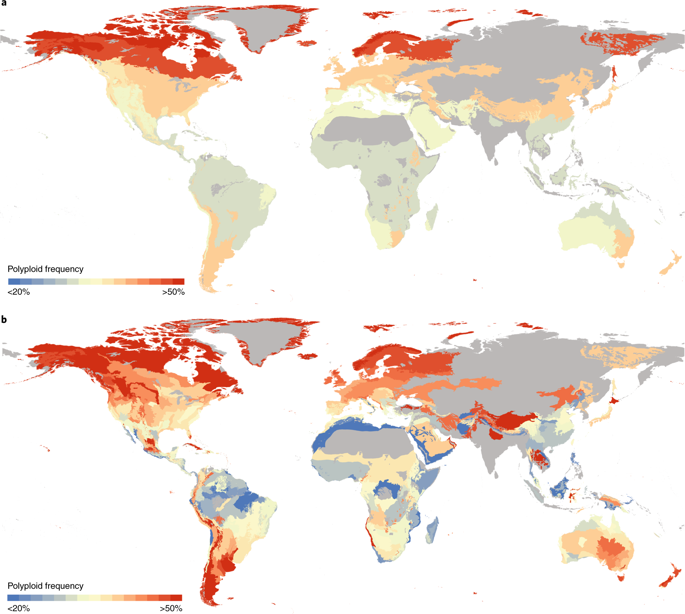Nature Ecology & Evolution ( IF 13.9 ) Pub Date : 2019-01-29 , DOI: 10.1038/s41559-018-0787-9 Anna Rice , Petr Šmarda , Maria Novosolov , Michal Drori , Lior Glick , Niv Sabath , Shai Meiri , Jonathan Belmaker , Itay Mayrose

|
Deciphering the global distribution of polyploid plants is fundamental for understanding plant evolution and ecology. Many factors have been hypothesized to affect the uneven distribution of polyploid plants across the globe. Nevertheless, the lack of large comparative datasets has restricted such studies to local floras and to narrow taxonomical scopes, limiting our understanding of the underlying drivers of polyploid plant distribution. We present a map portraying the worldwide polyploid frequencies, based on extensive spatial data coupled with phylogeny-based polyploidy inference for tens of thousands of species. This allowed us to assess the potential global drivers affecting polyploid distribution. Our data reveal a clear latitudinal trend, with polyploid frequency increasing away from the equator. Climate, especially temperature, appears to be the most influential predictor of polyploid distribution. However, we find this effect to be mostly indirect, mediated predominantly by variation in plant lifeforms and, to a lesser extent, by taxonomical composition and species richness. Thus, our study presents an emerging view of polyploid distribution that highlights attributes that facilitate the establishment of new polyploid lineages by providing polyploids with sufficient time (that is, perenniality) and space (low species richness) to compete with pre-adapted diploid relatives.
中文翻译:

多倍体植物的全球生物地理
了解多倍体植物的全球分布是了解植物进化和生态学的基础。据推测,许多因素会影响全球多倍体植物的分布不均。然而,缺乏大型比较数据集已将此类研究限制在本地菌群和狭窄的分类学范围内,从而限制了我们对多倍体植物分布的潜在驱动力的理解。我们根据广泛的空间数据以及成千上万种的基于系统发育的多倍体推断,提出了描绘全球多倍体频率的地图。这使我们能够评估影响多倍体分布的潜在全球驱动因素。我们的数据揭示了明显的纬度趋势,多倍体频率远离赤道而增加。气候,尤其是温度 似乎是多倍体分布的最有影响力的预测因子。但是,我们发现这种影响主要是间接的,主要是由植物生命形式的变化介导的,而在较小程度上是由生物分类组成和物种丰富度介导的。因此,我们的研究提出了多倍体分布的新兴观点,该观点突出了通过为多倍体提供足够的时间(即多年生)和空间(物种丰富度低)来与预先适应的二倍体亲缘竞争而促进新的多倍体谱系建立的属性。































 京公网安备 11010802027423号
京公网安备 11010802027423号